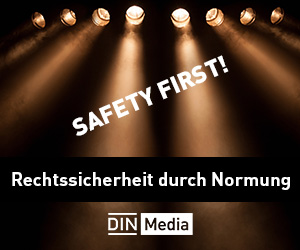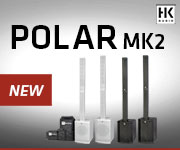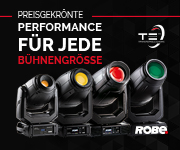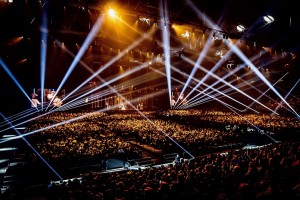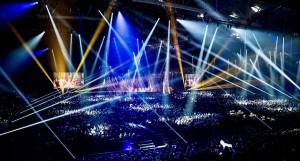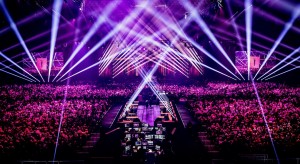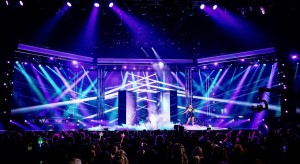Aktuelle News & Schlagzeilen
Robe supports Melodifestivalen 2020
Since 1959, each year the Swedish entry to the Eurovision Song Contest (ESC) has been chosen via an annual televised talent competition, known since 1967 as the Melodifestivalen, organised by public broadcasters Sveriges Television (SVT) and Sveriges Radio (SR). In 2002, the Melodifestivalen started touring to six key cities around Sweden with a final in Stockholm, this year at the 65,000-capacity Friends Arena.
Swedish LD Fredrik Jonsson of Eyebrow Designs has lit Melodifestivalen since 2002. This year he enlisted the help of 168 x Robe moving lights (upped to over 300 for the final show) including MegaPointes, Spiiders, LEDBeam 150s and six BMFL WashBeam follow spots running on four RoboSpot remote BaseStations.
The producers wanted a large open stage look to set the scene, so they could use more and bigger props for the songs to give each an individual look. Set designer Viktor Brattström opted for a large projection surface as the backdrop, which was divided into three sections - in a geometric horseshoe shape, with content fed by eight laser projectors.
Several moving ladders were rigged with MegaPointes. Out of a total of ten ladders, four could move sideways on a Gerriets Cargo Track system, supplied by Creative Technology Northern Europe together with the lighting. This trick enabled the ladders to slide in and appear in front of the SR/SL backdrop upstage. Each ladder was rigged with two heavy duty runner blocks (rollers) as rigging points on the top pipe. These runner blocks were then attached to the Cargo Track beam, a set up that facilitated moving the ladders into view and choosing the best configuration for any song.
When projection needed to cover the whole backdrop, the ladders were slid out of view and stored - two ladders each side of stage - behind the diagonal projection screens, in an area called “the garage”. The Cargo Track beam reached well outside the “horseshoe” corners, creating the hidden storage position.
Sometimes the ladders were positioned on stage in conjunction with the projection, so “masks” in the projection were mapped in the Disguise servers for the different ladder positions, keeping them dark and out of the projected image. The ladders were slid in and out of position manually by the lighting crew during set changes. There were five different positions for each ladder.
Surrounding each section of backdrop was a tower/ladder filled with MegaPointes (64 in the touring system) plus a bunch of strobes. Approximately five meters downstage was another arch in the same horseshoe shape, also with towers and lights arranged similarly to create a mid-stage performance area.
Scattered around all the towers and in the roof beams were numerous Roe LED strips arranged in geometric patterns. Two big DS/US staircases at 45-degree angles to the downstage arches further dissected and defined the main performance area, and inside the stairs pointing outwards onto stage were a bunch of LEDBeam 150s.
The over-stage lighting rig followed the horseshoe shape of the stage, with 5 x US/DS trusses crammed as tightly as possible with spots, washes, and strobes. An extra upstage truss was dedicated to backlighting, including fixtures doing gobo-washes and the six BMFL WashBeams follow spots on the RoboSpot systems.
Robe’s Spiider LED wash beams in the roof were the main wash fixtures, the first time Fredrik Jonsson has used them in this way. The MegaPointes were all positioned on the 10 x towers and utilized for aerials and effects as well as for some extra lighting ‘props’ in specific songs. For Melodifestivalen 2020, the 42 x LEDBeam 150s on the touring system were rigged in the roof in groups of four to simulate ACLs, with the rest built into the set stairs to provide eye-candy, side light and more effects.
The BMFL WashBeams were they key lights, back lights and follow spots with a few extras rolled in when Jonsson needed to boost the sidelight. The intensity of two BMFL WashBeams was mapped in the Disguise media server to sync with the video content during one song.
WashBeams were chosen for all the fixed positions to cover the show hosts and interval acts. They were also used as side and key lights for the dancers, especially trimmed with the blade system and with a blurred breakup gobo slipped in to add more texture and make artists stand out in crowded dance acts.
An additional 59 x BMFL WashBeams and 74 x BMFL Wash XFs joined the rig for the final broadcast to cover the audience and floor areas around the arena. The lamp count was ramped up dramatically for the final, mainly due to the vastness of the Friends Arena (capped at 30,000 for this show), a soccer venue where fixtures at 28 meters had to be able to cover the audience.
The four RoboSpot systems were positioned backstage and controlled the six BMFL WashBeams on the back truss. “It is a trick employed last year to cover different sweet spots/performance areas from two different angles,” says Jonsson. The show lighting was programmed and run on four GrandMA consoles.
Joining Fredrik Jonsson on the 2020 Melodifestivalen tour were a team including technical director Tobias Åberg, lighting operators Timo Kauristo and Robert Kelber, video operator Fredrik Stormby, lighting crew chief Peter “Angry” Andersson, and Calle Brattberg who was the additional lighting operator for the Friends Arena Grand Final.
(Photos: Sofia Drevemo/Creative Technology)
SCHLAGZEILEN
news archiv
suche
© 1999 - 2025 Entertainment Technology Press Limited News Stories

